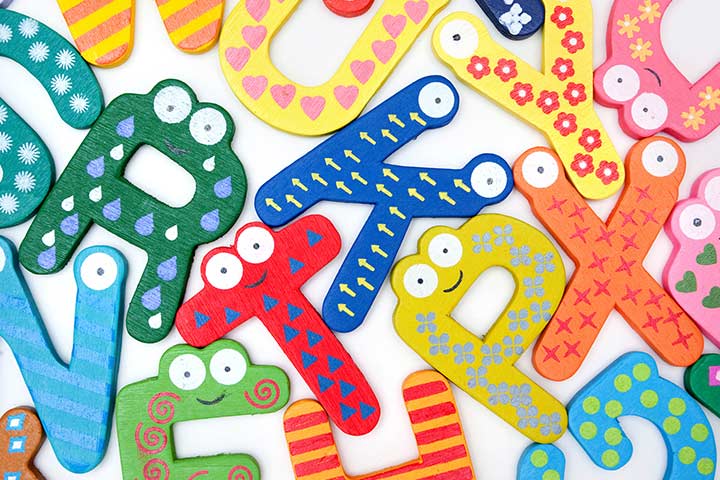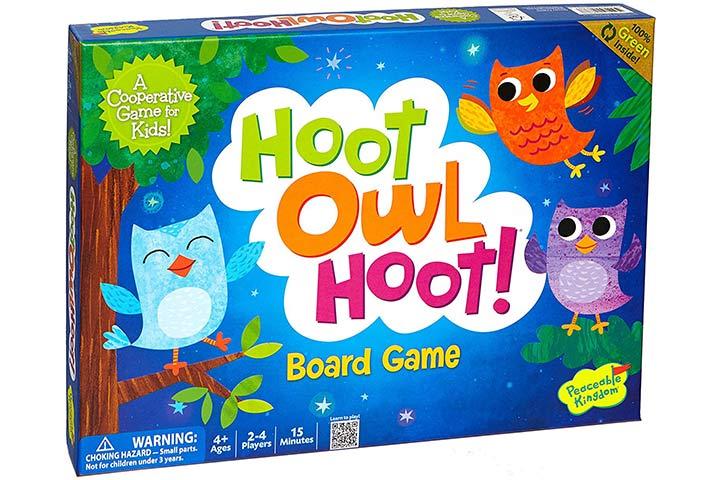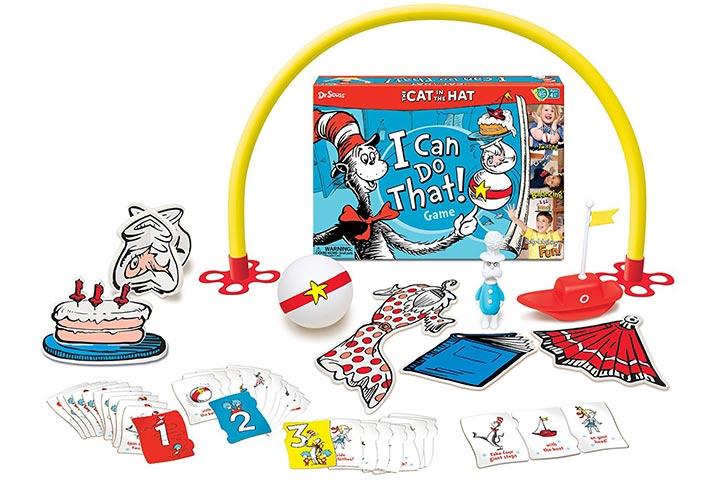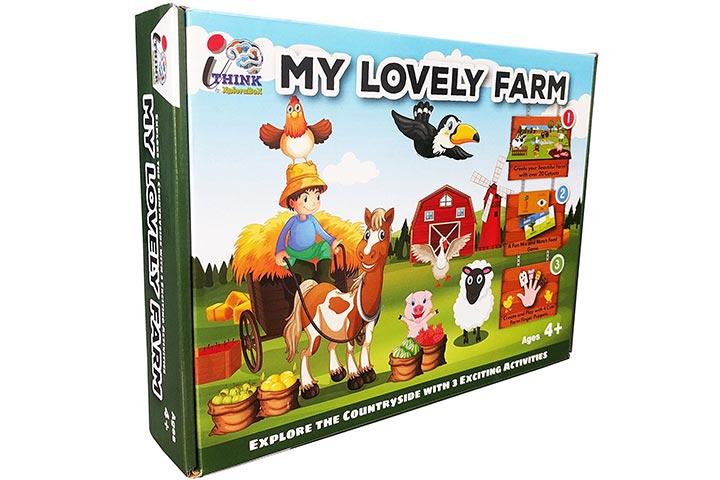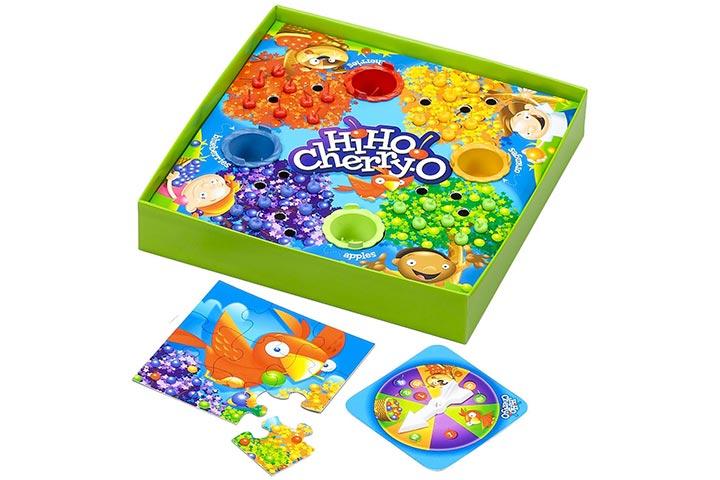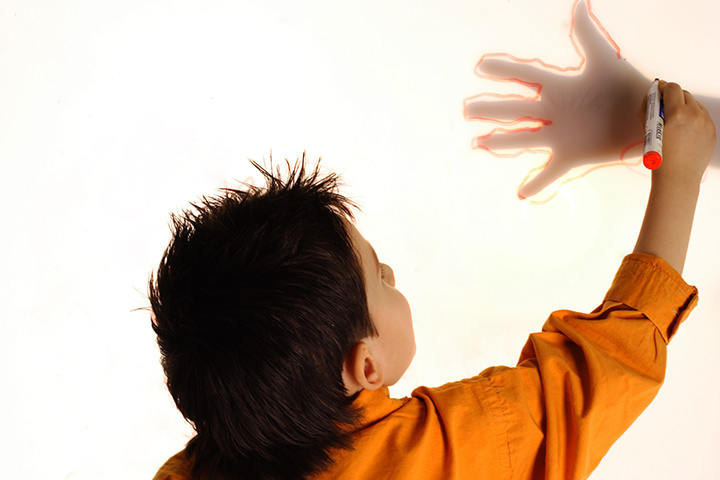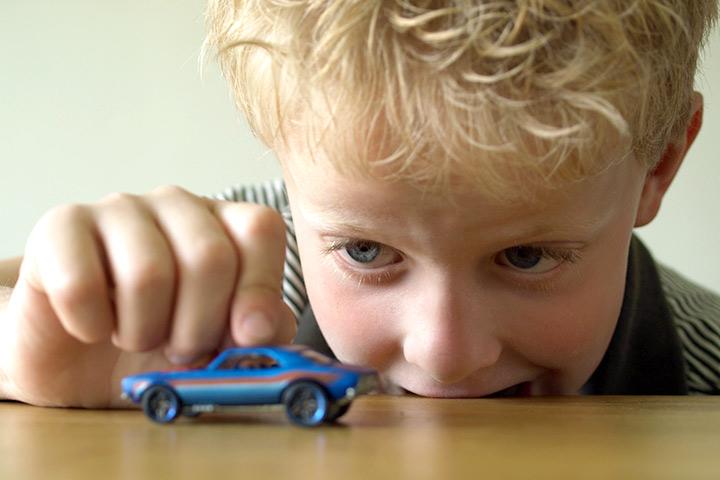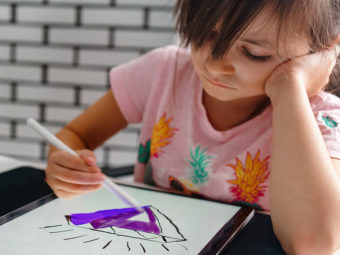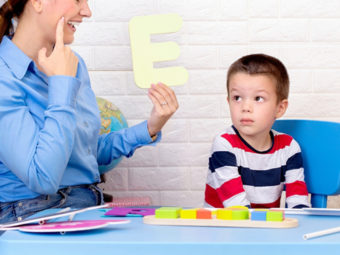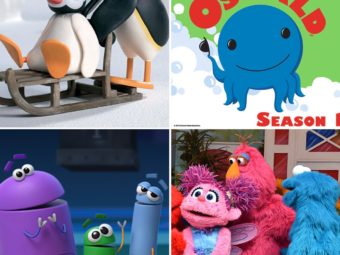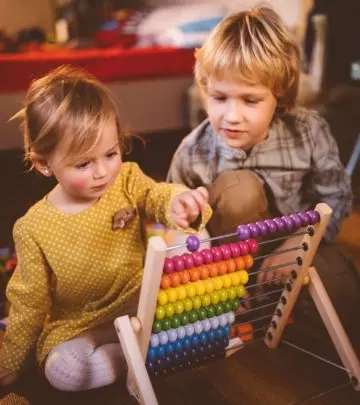
Image: Shutterstock
Jump to:
Games for 4-year-olds must be age-appropriate and designed to cater to their growing needs. Children aged four are playful and have oodles of energy. And that energy must be directed constructively. Children in this age group can skip, jump, run, and hop. They can kick balls around or use clay and sand to create shapes.
So, if you are looking for games for 4-year-olds, here are some options to pick from and let your child have lots of fun.
Exciting And Fun Games For Four-Year-Old Kids
Children aged four can pay attention to activities for up to 15 minutes, or less if it is something that they do every day (1). Considering that, we have compiled a list of easy games for four-year-old kids.
1. What’s hiding in the jelly?
Jelly is not just for eating. You can also use it for fun.
You will need:
- Edible jelly crystals of different colors
- 1-2 large trays
- Plastic containers of different shapes
- Plastic numbers, small toys and wooden beads, and anything else that can be put inside a cup of jelly
How to:
- You will need to prepare the jelly cups before starting the game.
- Arrange the plastic cups or bowls in a tray and put one plastic number, letter, toy, or bead in each.
- Give each child a few minutes to dive into their curiosity and explore the jelly and guess what’s inside without looking.
If they cannot guess, let them look and say what they found! Either way, they learn about the sense of touch and feel.
 Quick tip
Quick tip2. Drinking straws and pom poms
This is a fun indoor game that you can play with even one kid, provided you have the accessories ready.
You will need:
- Colorful scotch tape – at least three colors are good
- 5-6 1-inch pompoms
- Drinking straws
How to:
- Create a maze or a path using scotch tape, by sticking it on the floor. Pick whatever design you like. But just don’t have straight lines (what fun is that!). Mark the start and end points on the paths.
- Give the kids a drinking straw each.
- Put the pompoms in a basket.
- On ‘go’, the child has to pick a pompom from the basket, put it on the taped lines on the floor, and blow air using the straws to move it along the lines.
- They have to go from start to end to complete the game. The kid who finishes the race in the shortest time is the winner.
3. Rock, paper, scissors
Whether you have a lot of time on your hands or need help choosing whose turn it is first at something, you play rock, paper, scissors.
You will need:
- Space and time to playtime
How to:
- Give the kids clear instructions about the game.
- Rock means a “fist”, paper is to place the hand palm down, with the fingers stretched out, and scissors are to use two fingers to look like a pair of scissors.
- Rock can break the scissors, the scissors can cut the paper, and the paper can cover the rock. So rock is stronger than scissors, scissors is stronger than paper, and paper is stronger than rock.
- This interactive and engaging game is usually played by two people, who stand facing each other with their left palm facing up and the right hand clenched like a fist.
- The kids hit the fist on the palm twice, and the third time they can keep it as a rock, or change it to paper or scissors.
One with the stronger weapon wins.
4. ABC Maze
The ABC maze is an innovative way to teach your child the alphabet. The game is physically and mentally challenging and stimulating.
You will need:
- Sheet of paper
- Pen or sketch
- Space to play
- A small toy car or animal
How to:
- Cut the sheets or paper into long strips and create a maze. Make a medium-sized maze in such a way that it is easy to navigate from the starting point to the end.
- Write the letters of the alphabet in order on the maze, so that the child can move from one letter to another in the right order.
- Give the child the toy car or animal and ask him to move from one letter to the other, until he completes the alphabet.
5. Hopscotch game
Image: Shutterstock
The hopscotch game for kids is a fun and engaging way to encourage physical activity and coordination.
You will need:
- A chalk or tape (depends on whether you are playing outdoors or indoors)
- A small stone
How to:
- Use chalk or tape to make the hopscotch grid, of 8 or 10 square grids.
- Start numbering the squares 1, 2, and 3 in a line, followed by squares 4 and 5 go next to each other side by side. Square 6 should be in line and then 7 and 8 together, followed by square 9. The last square, number 10 can also be added.
- Start by throwing a small object into the first square, ensuring it lands inside without touching the border or bouncing out. If the object lands on a line or outside the square, you lose your turn.
- Hop on one foot through the empty squares in numerical order, skipping the one with the stone. At paired squares (like 4-5 and 7-8), land on both feet, one in each square.
- In square 10, land with both feet, turn around and head back to the start. Pick up the stone on one foot when you reach the marked square and complete the course.
Video Games and Board Games For Four-Year-Olds
Board games are a great way to get your four-year-old child to interact with other people. Video games can make them imaginative but should be played in moderation.
6. Hoot Owl Hoot
Hoot Owl Hoot is one of the most popular board games for four-year-olds. Developed by Peaceable Kingdom, this game has colored codes and encourages cooperative play.
What we like about it: This game is easy to play and has a simple strategy that encourages kids to indulge in teamwork and build friendships. The game aims to help the owls fly back to their nest before sunset. It helps in developing the kids’ social interaction skills and instills the idea that when we work in a team, everyone wins.
Why the kids love it: There is no loser in this game. There are just winners if the kids succeed in moving the owls back to their nests. Also, there is no reading or writing involved, just thinking and executing!
7. Cat In The Hat, I Can Do That!
This is an interesting board game based on Dr. Seuss’ book, The Cat in the Hat.
What we like about it: The name of the game itself says it – I Can Do That! This game lets the kids find out different things they can do for fun. The game can surprise your child and let them discover their latent talents. The game is designed to bring families and friends together.
Why the kids love it: Cat In The Hat, I Can Do That lets the children enjoy the book by Dr. Suess in a different yet entertaining way. The game helps children better understand their abilities and helps build their confidence. Every time the kids say “I can do that” and complete a task, they are pushing their levels of self-esteem further up!
8. World of Zoo
There are several zoo simulator games, but none gets close to being as creative as this one.
What we like about it: Simulation games are always better than mindless video games with violence and action. World of Zoo is a simulation game that teaches your children how to interact and build a relationship with the animal world, teaching them to respect their surroundings. The game introduces the children to different animals, their natural habitat and their food habits. What’s best is that the game comes with National Geographic animal fact cards.
Why the kids love it: World of Zoo is a colorful video game that can be played on a PC as well. The animal editor feature lets the children interact with different animals and also lets them change their colors, patterns, and features to some extent, to create a unique animal.
9. My Lovely Farm
A colorful board game, My Lovely Farm takes your children to the world of farming, growing vegetables, and taking care of animals.
What we like about it: The game is more than just setting up a farm. There are three activities that the kids can indulge in – building the farm, creating puppets, and using fact cards to learn about farming, farm animals, benefits of vegetables, and so on. The kids can switch from one activity to the other if they are bored, and engage in imaginative play for hours.
Why the kids love it: Besides being able to build a farm of their own, the kids will also be able to color the animal cutouts, make puppets and have their own puppet shows with Mrs. Cow and Ms. Chicken as the hosts! Sounds fun, doesn’t it? Well, it is. Play with your kid, and we guarantee he’ll agree as well.
10. Hi-Ho Cherry-O
Which parent wouldn’t want an educational game for their four-year-old kid? Well if you do, then here is one that could interest you.
What we like about it: Hi-Ho Cherry-O is a fun way to teach your little one basic math skills. The game is about picking cherries and putting them in the bucket. The more cherries they pick, the faster they can fill the bucket and win. As they play, children will be adding, subtracting, and counting fruits to fill their buckets.
Why the kids love it: The game has an arrow-based spinner, four fruit baskets, a 9-piece puzzle, and ten fruit pieces each of blueberry, cherries, apples, and oranges. The game can be competitive and allows kids to have fun picking fruits and putting them in their tiny fruit baskets. The spinner, which is used in place of a pair of dice, is perhaps the most exciting component of the game.
Eight Simple Activities For Four-Year-Olds
This is the list of activities that will keep your four-year-olds busy and you happy.
11. Number rolling game
Rolling on the floor is silly, but it is fun when you are a four-year-old. Wondering what we are talking about? Keep reading.
You will need:
- Post-it notes
- Pen
- Lots of space to play
- A clear wall or board
How to:
- Clear some space in your living room or your child’s bedroom.
- Take around 20 self-adhesive post-it notes and write a number each on them. Pick numbers between one and 20 and do not repeat a number.
- Put the post-it notes on the floor, with the sticky side up.
- As your girl to get the notes from the floor, without using her hands or feet. She can only get them with her body, which means she has to roll on the floor to get all the notes to stick to her.
- Ask her to arrange the numbers on the wall in the proper order. This will teach her sequencing.
Doesn’t it sound like a math lesson disguised as a fun activity? Well, it is!
12. Play acting
Play acting or role-playing is an excellent way to teach children about different people or professionals they will come across. Think about a few pretend play options you can try with your kids. Some examples are:
- Going to the supermarket
- Seeing a doctor
- At school
- At the airport
- On the road
- Visiting a friend’s house
- Cruising on a ship
Another great idea for play acting or make-believe skits is to act out a storybook. Let your child pick a storybook and the character he wants to be. Let the other kids or adults be the other characters (you can play multiple characters if there aren’t enough people).
The idea of playacting can be used to give kids hands-on experience on how to behave and how not to behave in different situations in a social setting. You can also think about other scenarios besides the ones mentioned above, if you think it is relevant for your child’s age and temperament.
13. Book exploration
Book exploration is an excellent activity that we think can make reading a more interesting activity for a child. So how do you do this?
- Take the child to a library and show them how it works. Be sure to tell them the thumb rule before entering the library: silence.
- Or go to a bookstore and let them explore different books there. You could sit and read for a bit and maybe buy a book for them too.
- Attend a book reading or storytelling session for children and let them experience the wonders of fiction and fantasy.
Make bedtime story reading a habit. When you read to them, they will develop an interest in books as well.
 Point to consider
Point to consider14. Nature walks
A walk or hike in the woods is perhaps the best outdoor activity that you can indulge your child in. If you have a park or a national park nearby, make it a point to take your child there at least once a month or two. Some of the things you can try during such walks include:
- Bird watching
- Nature photography
- Drawing or sketching the landscapes
Your four-year-old may not be able to do much with a camera or paintbrush. At such times, you could just teach the little one to experience and enjoy the sounds of nature.
 Quick tip
Quick tip15. Touch and feel – sensory bag
Kids are so focused on seeing things, sometimes hearing, that they do not use their sense of touch for anything. This game focuses on just that – their sense of touch. You can use this game to help them identify objects by their shape, texture, and how soft or hard it is.
You will need:
- A tote bag
- Objects of different shapes, size, and texture
- Blindfold cloth
How to:
- Pick objects such as a ball, comb, pen, fruit, vegetable, toy, key, and so on, and put them inside the bag.
- Blindfold the child and ask him to pick an object from the bag. The child has to use his hands to touch and feel the object and guess what it is. The other kids can give the child some clues about the object and help them guess.
- Now ask the children to put their hand inside the bag, one at a time.
- If the kid guesses it right, he gets a point. Otherwise, he gets another chance to guess another object. The objects don’t go back into the bag once they are out.
Kids can take turns to play this game at parties, in classrooms and other community events.
16. Shadow tracing
A unique idea that can keep your child busy for hours, shadow tracing lets you use the everyday objects to create some art.
You will need:
- Toilet paper rolls, tins or cardboard figures
- Glue
- Chart or drawing paper
- Pencil
- Space on the floor for the project
How to:
For this activity, you would need light, natural or otherwise, to create a shadow. Sunlight can be tricky, for you will need to trace the object faster, before the light moves and changes the angle.
- Spread the drawing paper or chart paper flat on the floor, somewhere close to a window, where there is light.
- Stack the toilet paper rolls to form the shape of a castle.
- Using a pencil, trace the shadow of the toilet paper castle on the chart or drawing sheet.
- Once done, replace the stack with some other object such as a tin can, a teddy bear, or anything else that can be traced clearly on the paper, solely by its shadow.
You can create as many such sketches as you want, in different sizes depending on the placement of the object and how far or close it is to the light.
Fun tip: Instead of inanimate objects, you can have people stand in the light and trace their shadow. So your child can trace you, your spouse or partner, or even a pet.
17. Drawing upside down
In this activity, the drawing is not going to be upside down. The artist will be! Wondering how that will work? Just keep reading, and we will tell you how.
You will need:
- Drawing sheets
- Sketches or crayons
- Drawing pencils
- High chairs or dining table chairs
How to:
- Cut the chart or drawing sheets into squares that fit under the seat of the chair.
- You can outline the design on the sheet and stick them to make it easier for the kid.
- Place a mat on the floor and give the kid some crayons or sketches.
- Ask the kid to crawl under the chair, such that he or she is facing the drawing paper stuck to the bottom of the chair.
- Use the crayons to draw or paint anything you want while looking upside down!
This is a fun activity and is best indulged in less often when your child is having one of the bad moods and needs a timeout.
18. Painting with wheels
Painting and art are creative activities that boost your child’s imagination. This activity indulges in painting with car wheels and not brushes.
You will need:
- 3-5 drawing sheets or chart sheets
- Toy cars, small ones
- Washable, organic paints
- Large bowls for mixing colors
How to:
- Mix the paints on a large plate or tray. You can also use a big bowl if your cars are small enough.
- Dip the tires of the toy car or truck in the paints and let you child move them along the drawing sheet or the floor, if you are okay with that.
- Your children can just draw straight lines or can create designs with the tires.
This is a fun activity that the children can indulge in from time to time if you don’t mind the cleaning afterward.
Frequently Asked Questions
1. Why are board games important for preschoolers?
Playing board games can activate brain parts involved in thinking and memory development. It can also help build logical and spatial reasoning. Preschoolers can learn to detect and identify patterns and letters through board games. These games also enhance gross and fine motor skills.
2. What do preschoolers learn from playing games?
Be it indoors or outdoors, children can learn and develop a lot from playing games. They learn to get along, collaborate, communicate, solve problems, and resolve disagreements while playing games with one another.
3. What are some memory games that 4-year-olds can play?
Uno, Simon Says, Go Fish, Picture Bingo, and Matching Card games are a few memory games children aged four and above can play.
4. How can I modify a game to make it easier or more challenging for my 4-year-old?
Introducing visual aids, simplifying/complicating the rules, providing additional hints, adjusting the game duration, introducing restrictions, adjusting game materials, such as using larger cards with clear and distinct pictures or symbols for easier identification, and offering practice rounds are some ways you can tweak a game’s challenge level
If you have played most of the games mentioned above and want to explore something more, then we have a bonus game for your child; the good old video games series, Pac-man. Blogger Andy Baio shares his experience of introducing his four-year-old to Pac-man. He says, “On Eliot’s fourth birthday, I started him with a Pac-Man plug-and-play TV game loaded with arcade classics — Galaxian (1979), Rally-X (1980), Bosconian (1981), Dig Dug (1982), and of course, Pac-Man (1980) and three sequels, Super Pac-Man (1982), Pac-Man Plus (1982), and Pac & Pal (1983). Until the moment he picked up the joystick, part of me secretly dreaded he’d have no interest in it…Eliot’s obsessed with playing Pac-Man on our TV. It’s like watching myself in 1982. He got better quickly. Six weeks later, he was beating my high scores in Dig Dug and regularly getting to higher stages of Pac-Man and its sequels (i).”
4-year-old children are like little photons. Channelizing their energies in the right direction can help them learn much while having fun. Rock-paper-scissors, play-acting, ABC maze, and nature walks are some all-time favorites. These games and activities have been handpicked keeping the skills, preferences, and developmental milestones of four-year-old children in mind (2). Keep in mind that each child has different preferences and skillsets. Hence, if the activities listed in this article seem too complicated or simple for your child, you may tweak them accordingly.
Key Pointers
- 4-year-olds are energetic and enjoy skipping, jumping, running, and sensory play with clay and sand.
- For your 4-year-olds, keep the games short and interesting, as they have a limited attention span of about 15 minutes.
- Games like Hoot Owl Hoot inspire social interaction, such as turn-taking and cooperation.
- You can also introduce classic games like Hopscotch, which helps them improve their physical coordination.
Infographic: Explore The World With Board Games
Board games have been the life of family gatherings, bringing people together for a time filled with fun and laughter. So how do other people across the world enjoy their family time? Use this infographic and track down the different board games from around the world to play with your family. Illustration: Momjunction Design Team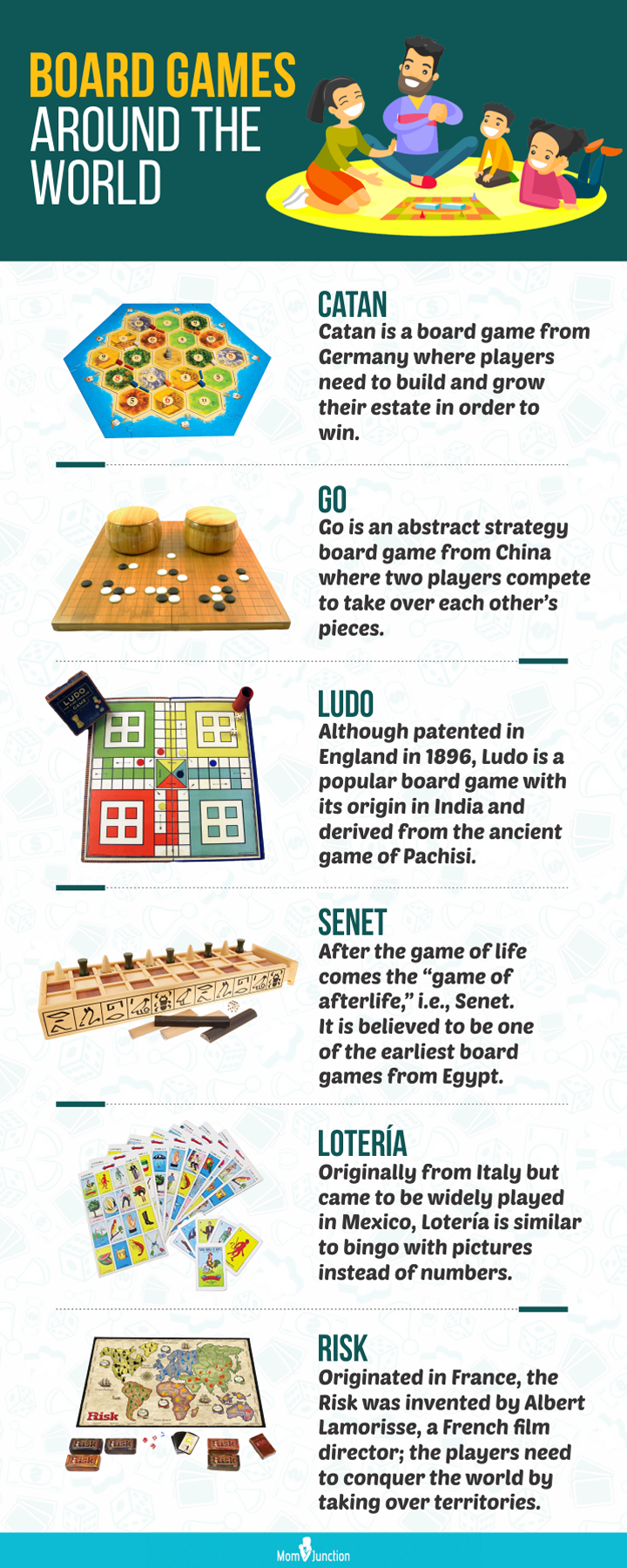
Join us for fun and games for children 4 to 5 years old. We’ll show you activities that will keep your kids entertained and engaged.
Personal Experience: Source
MomJunction articles include first-hand experiences to provide you with better insights through real-life narratives. Here are the sources of personal accounts referenced in this article.
i. Playing with my son.https://medium.com/message/playing-with-my-son-e5226ff0a7c3








